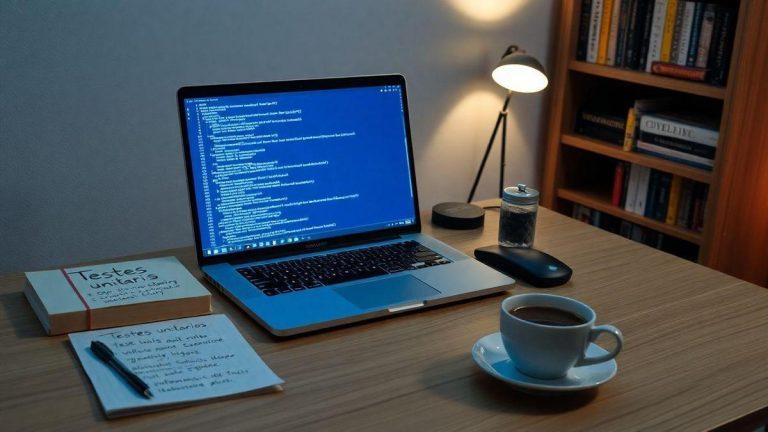Unlocking the Terminal: Essential Commands for Developers
Unlocking the Terminal: Essential Commands for Developers It's like opening the vault of nerd knowledge. In this article, I'll share my adventures with Terminal, that friend who seems complicated but is actually the superhero of boring tasks. Get ready to discover how automation, development tools and even the funniest mistakes can transform any programmer's routine into something fun and productive! Let's join us on this hilarious journey through the world of commands and make the Terminal less scary and much more useful!
Essential Terminal Commands for Beginners
What is Terminal and why do I need it?
Ah, the Terminal! This magical place where I type and suddenly things start to happen. You know when you want to do something, but don't want to click a thousand buttons? That's when the Terminal comes in like a superhero! It's a tool that allows me to interact with my computer more directly. Instead of clicking, I type commands and, voila, anything happens!
So why do I need it? Besides looking a lot smarter (and a little cooler), Terminal helps me automate tasks, manage files, and even program. It's like having a magic wand, but instead of casting spells, I code!
The first commands every developer should know
Now, let's get to the point: the commands! Here are some commands that I consider essential for beginners. They are like alphabet from the Terminal. Without them, you won't get very far!
| Command | What it does? |
|---|---|
| ls | Lists the files and folders in the current directory. |
| CD | Change directory. (Ex: cd Documents) |
| mkdir | Creates a new folder. (Ex: mkdir Projects) |
| rm | Removes files or folders. (Be careful with this one!) |
| touch | Creates a new file. (Ex: touch file.txt) |
These commands are like the triad For beginners. With them, I can already do some pretty cool things. And, of course, there's always dear rm, who's like that friend you can't leave alone at a party... he can ruin everything!
How Terminal Can Save My Day
One time, I was working on a project and suddenly my computer decided it didn't want to work anymore. The screen went black, and I thought, "Today's the day I cry." But, like a true code warrior, I opened Terminal and used the ls command to check if my files were there. And guess what? They were! I made a quick backup and saved the day!
Terminal is like that friend who always has a solution. When things get complicated, I know I can count on it to help me out. With a few commands at my fingertips, I feel more confident and prepared to face any challenge.
Automating Tasks with Shell Scripts
What are shell scripts and how can I use them?
Ah, the shell scripts! For those unfamiliar, they're like a programmer's magic wand. Just imagine: you can perform a ton of repetitive tasks with just one click (or rather, one command). Basically, a shell script is a text file containing a series of commands that your terminal can execute. It's like writing a recipe, but instead of baking a cake, I'm making my computer work for me!
To use a shell script, all you need to do is create a file with the .sh extension, write your commands, and then grant it permission to execute. It's that simple! Here's how I do it:
- I create a file: touch my_script.sh
- I edit the file: nano my_script.sh
- I give permission to execute: chmod x my_script.sh
- I execute: ./my_script.sh
Ready! Now I'm the master of my terminal!
Practical examples of automation that I love
Now, let's get to the point: how I use these scripts to make my life easier. Here are some examples I love that might help you get started with automation:
| Boring Task | My Shell Script |
|---|---|
| Back up files | tar -czvf backup.tar.gz /my_data |
| Rename multiple files | for f in .jpg; from mv “$f” “${f%.jpg}.jpeg”; done |
| Update my system | sudo apt update && sudo apt upgrade -y |
These are just a few examples, but the list is endless! I've written scripts for just about everything: from organizing my downloads to sending daily reports via email. It's like having a personal assistant, but without the coffee!
Turning Boring Tasks into Fun with Scripts
And best of all? I can turn those tasks that used to make me sleepy into something fun! For example, I created a script that plays a random song every time I perform a boring task. This way, while my computer does the hard work, I'm dancing in my chair. Who said programming can't be fun?
Development Tools I Can't Live Without
My favorite tools for optimizing workflow
Ah, the development tools! They're like the superheroes of programming, always ready to save the day and make my work easier and more fun. Let's get started, I'll share some of my favorites.
- Visual Studio Code: This is mine partner inseparable. It's light, fast, and has tons of extensions. Not to mention I can customize everything! It's like having a coffee warm while I program.
- Git: Ah, Git! It's like that friend who always saves your ideas before you lose them. With it, I can go back in time and fix my mistakes. It's like having a undo button in life.
- Postman: For those who work with APIs, Postman is a savior. It helps me test and organize my requests. It's like having a party of data in the palm of your hand!
How Terminal Helps Me Be More Productive
If there's one thing I've learned, it's that Terminal it's mine best friendIt may seem intimidating at first, but trust me, it's like learning to ride a bike. Once you get the hang of it, you won't want to stop!
With the Terminal, I can do a lot of things quickly. For example, run commands, navigate between folders, and even run scripts. It's like having a magic wand that makes everything happen faster.
Tips for choosing the best tools
Now, if you're wondering which tools to choose, here are some tips that work for me:
- Search: See what other developers are using. The internet is full of opinions and reviews.
- Test: Don't be afraid to experiment! Many tools have free versions. It's like a taste test before buying the ice cream.
- Prioritize: Choose tools that suit your work style. There's no point in having a great program if you don't know how to use it.
| Tool | Main Use | Satisfaction Rating |
|---|---|---|
| Visual Studio Code | Code editing | ⭐⭐⭐⭐⭐ |
| Git | Version control | ⭐⭐⭐⭐⭐ |
| Postman | API Testing | ⭐⭐⭐⭐⭐ |
Systems Administration: The Terminal as My Best Friend
Administration commands every developer should know
Ah, the Terminal! This is my best friend, and if you're a developer, I'd say it should be yours too. You know that friend who always has a solution for everything? Well, that's the Terminal. Here are some commands I consider essential for anyone wanting to make friends with this powerful tool:
- ls: To list files and folders. It's like opening the refrigerator and seeing what food is in there.
- cd: To change directory. Like choosing what you're going to do today: "Today I'm going to the projects folder!"
- mkdir: To create new folders. It's like giving a new name to a child, only less complicated.
- rm: To remove files. Be careful! It's like throwing away that birthday present you never used.
These commands are like the cake recipe of programming. Without them, you could end up lost in the kitchen!
How I manage servers with ease
Managing servers can seem like a daunting task, but with the Terminal, it becomes much easier. I remember the first time I had to restart a server. I was more nervous than a cat on moving day! But with a few commands at my fingertips, everything went smoothly. Here's how I do it:
- Connection: I use the ssh command to connect to the server. It's like opening the door to a friend's house.
- Updates: Run the sudo apt update command to ensure everything is up to date. Nobody likes visiting a friend who doesn't clean their house, right?
- Monitoring: The top command helps me see what's happening in real time. It's like looking out the window and seeing what the neighbors are up to.
The Terminal: My Superpower in Administration
If Terminal were a superhero, it would wear a cape and fly around solving all your system administration problems. It's fast, efficient, and best of all, it doesn't judge me when I make mistakes. Want to know how I feel when I use Terminal? It's like driving a sports car on an empty track. The adrenaline rushes and the freedom is total!
| Command | Description |
|---|---|
| ls | List files and folders. |
| CD | Change directory. |
| mkdir | Creates new folders. |
| rm | Remove files. |
| ssh | Connects to a remote server. |
| sudo apt | Updates packages on the system. |
| top | Monitors processes in real time. |
Productivity Optimization with Command Line
Tips to speed up my work in the Terminal
When it comes to Terminal productivity, I always say: If you're not using the command line, you're wasting time! It's like trying to cut a cake with a tablespoon. So, here are some tips I use to speed up my work:
- Know your commands: Learning basic commands is like knowing where the refrigerator is in your house. You don't want to have to look for it every time you're hungry!
- Use scripts: Instead of doing everything manually, I write scripts. It's like having a personal assistant who does the boring work for me.
- Customize your Terminal: I make my Terminal look like something I love. It makes me want to use it more. Think of it as the decoration in your living room. If it looks nice, you'll want to spend more time there!
How I use shortcuts to save time
Shortcuts are like superpowers to me. When I learned how to use them, my productivity skyrocketed. Here are a few I can't live without:
| Shortcut | Function |
|---|---|
| Ctrl C | To stop a command |
| Ctrl A | To go to the beginning of the line |
| Ctrl E | To go to the end of the line |
| Tab | To autocomplete |
These shortcuts are like a shortcut to my work. With them, I can get more done in less time. And who doesn't want that?
The secret to being faster than a rocket in the Terminal
If there's one thing I've learned, it's that to practice is the key. The more I use Terminal, the faster I get. It's like learning to ride a bike: at first, you fall, but then, you fly!
Another tip I use is organize my favorite commandsI created a file with the commands I use most. This way, instead of racking my brain, I can just look at my menu and choose what I want. It's like having a menu at lunchtime!
Common Errors and How to Avoid Them in the Terminal
The mistakes I made that you should avoid
Ah, the Terminal! This magical place where you can do amazing things... or make mistakes that make you wish you'd never left the graphical interface. As a programming student, I've experienced several embarrassing situations. Here are some mistakes I've made that you should avoid:
- Forget the command: One time, I typed rm -rf / instead of rm -rf folder. Let's just say my computer wasn't very happy.
- Copy and paste without looking: Careful! I once pasted a command that deleted important files. My heart stopped for a second.
- Using sudo without knowing: Ah, the power of sudo! But be careful, using it without knowing what you're doing can be like putting a bazooka in the hands of a child.
How I learned to deal with error messages
Learning to deal with error messages in Terminal was like learning to ride a bike. At first, I'd fall and hurt myself (not literally, I hope you understand). But over time, I realized that error messages are like life's warning signs. Here are some lessons I learned:
- Read the message: It seems simple, but I often ignored it. The messages contain valuable tips.
- Search: Don't be shy about searching on Google. The community is large, and there's always someone who's been through the same thing.
- Test: If something isn't working, try changing one thing at a time. It's like cooking: don't add all the ingredients at once!
Laughing at My Mistakes: How Terminal Taught Me to Be Better
Laughing at my mistakes was essential. Every slip-up in the Terminal became a funny story. Like the time I tried to change my username's password and ended up creating a new username called "disaster."
These experiences not only taught me, but also made me stronger as a programmer. Terminal is a great teacher, even if sometimes I have to learn the hard way.
So, next time you make a mistake, remember: it's just Terminal trying to teach you something new. And who knows, maybe a good laugh might be the best medicine!







